Bill of Lading 海运提单
- 格式:doc
- 大小:86.50 KB
- 文档页数:20
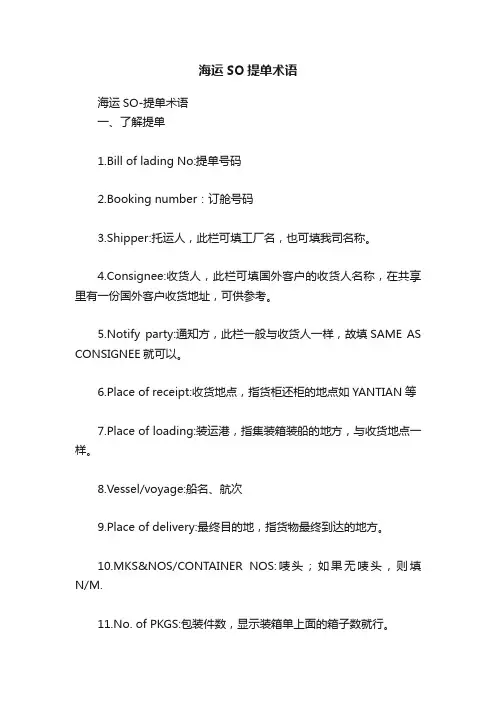
海运SO提单术语海运SO-提单术语一、了解提单1.Bill of lading No:提单号码2.Booking number:订舱号码3.Shipper:托运人,此栏可填工厂名,也可填我司名称。
4.Consignee:收货人,此栏可填国外客户的收货人名称,在共享里有一份国外客户收货地址,可供参考。
5.Notify party:通知方,此栏一般与收货人一样,故填SAME AS CONSIGNEE就可以。
6.Place of receipt:收货地点,指货柜还柜的地点如YANTIAN等7.Place of loading:装运港,指集装箱装船的地方,与收货地点一样。
8.Vessel/voyage:船名、航次9.Place of delivery:最终目的地,指货物最终到达的地方。
10.MKS&NOS/CONTAINER NOS:唛头;如果无唛头,则填N/M.11.No. of PKGS:包装件数,显示装箱单上面的箱子数就行。
12.Description of packages and goods:品名,主要说明产品的名称,如Furniture等。
13.Gross weight G.W(缩写):毛重,与关单上的毛重一致。
/net weight,净重14.Measurement:体积,写产品的立方数。
如果是20尺柜,范围在20~25CBM; (20GP)如果是40尺柜,范围在50~55CBM;(40GP)如果是40尺高柜,范围在60~65CBM; (40HQ)如果是45尺高柜,范围在70~75CBM。
(45HQ)15.提单上需注明:柜号,封号,可注于唛头的下方或上方。
16.如果成交术语是FOB(离岸价),需注明“FREIGHT COLLECT”.17.On board date:装船日期,报关日期后面两三天。
18.Place and date of issue:制单日期,可于装船日期一样,也可延后一两天。
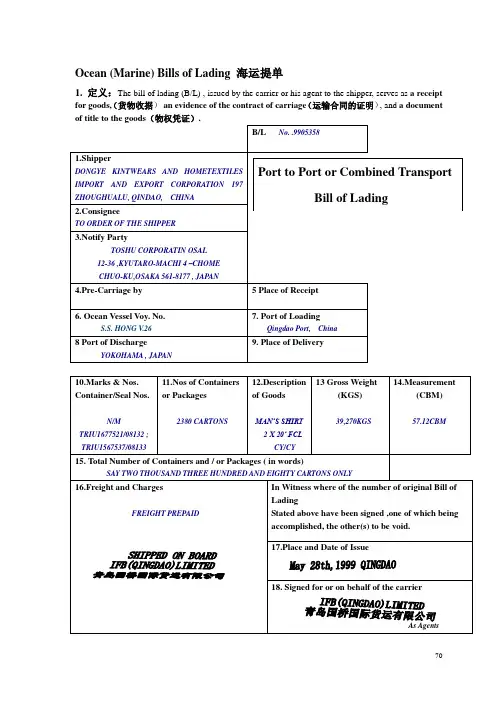
Ocean (Marine) Bills of Lading 海运提单1. 定义:The bill of lading (B/L) , issued by the carrier or his agent to the shipper, serves as a receipt for goods,(货物收据)an evidence of the contract of carriage(运输合同的证明), and a documentNote:关于提单缮制的详细说明如下:No.1.Shipper 托运人:托运人一般是出口商,除非信用证另有规定。
No.2.Consignee 收货人:也叫提单的抬头。
在信用证支付方式下,收货人一般做成指示抬头,凭托运人或开证行指示,要严格按照信用证的要求缮制。
参见“指示提单“。
No.3. Notify Party被通知人:被通知人一般是进口方,有时是货代或者开证行,必须按照信用证的规定填写。
船到港后,船公司会寄Arrival Notice 给被通知人,故地址和公司名称必须正确完整。
如果Consignee 和Notify Party 是同一个公司,可在此栏缮制“SAME”或”CONSIGNEE”的字样。
No.7 and No. 8 Loading Port and Unloading Port:意义不言而喻。
但来证规定:”China Port“ or “ European Main Port”, 应列出具体港口名。
如需要转运到内陆城市,如“Marseilles in transit to Geneva”,到货港填“Marseilles”,在货名或唛头栏内注上:”In transit to Geneva”.又如北美加拿大地区,来证规定:Los Angeles O.C.P. Chicago (Overland Common Points内陆地区),到货港制“Los Angeles O.C.P.” 在货名或唛头栏内注”O.C.P. Chicago”。
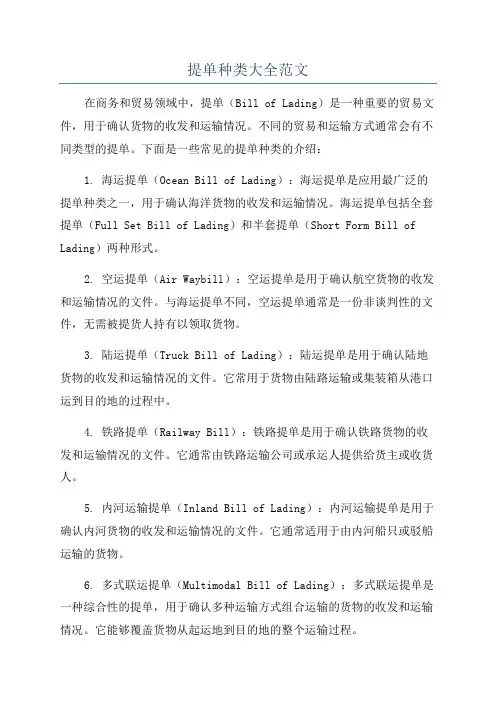
提单种类大全范文在商务和贸易领域中,提单(Bill of Lading)是一种重要的贸易文件,用于确认货物的收发和运输情况。
不同的贸易和运输方式通常会有不同类型的提单。
下面是一些常见的提单种类的介绍:1. 海运提单(Ocean Bill of Lading):海运提单是应用最广泛的提单种类之一,用于确认海洋货物的收发和运输情况。
海运提单包括全套提单(Full Set Bill of Lading)和半套提单(Short Form Bill of Lading)两种形式。
2. 空运提单(Air Waybill):空运提单是用于确认航空货物的收发和运输情况的文件。
与海运提单不同,空运提单通常是一份非谈判性的文件,无需被提货人持有以领取货物。
3. 陆运提单(Truck Bill of Lading):陆运提单是用于确认陆地货物的收发和运输情况的文件。
它常用于货物由陆路运输或集装箱从港口运到目的地的过程中。
4. 铁路提单(Railway Bill):铁路提单是用于确认铁路货物的收发和运输情况的文件。
它通常由铁路运输公司或承运人提供给货主或收货人。
5. 内河运输提单(Inland Bill of Lading):内河运输提单是用于确认内河货物的收发和运输情况的文件。
它通常适用于由内河船只或驳船运输的货物。
6. 多式联运提单(Multimodal Bill of Lading):多式联运提单是一种综合性的提单,用于确认多种运输方式组合运输的货物的收发和运输情况。
它能够覆盖货物从起运地到目的地的整个运输过程。
7. 仓库提单(Warehouse Receipt):仓库提单是确认仓库中存储货物的证明文件。
它通常由仓储公司或物流公司提供给货主或收货人。
8. 分单(Split Bill of Lading):分单是指在一份主提单下提取多份分运单的过程。
当一个主提单上载有多个运输目的地的货物时,货主可以请求拆分成多个分提单以便对每个运输目的地的货物进行独立处理。
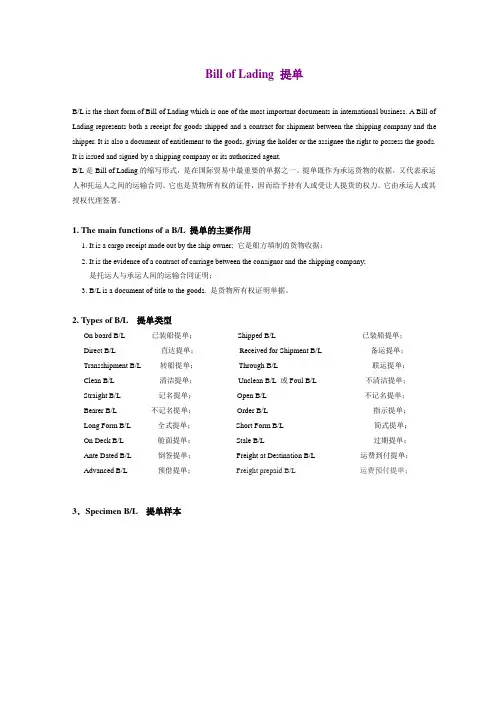
Bill of Lading提单B/L is the short form of Bill of Lading which is one of the most important documents in international business. A Bill of Lading represents both a receipt for goods shipped and a contract for shipment between the shipping company and the shipper. It is also a document of entitlement to the goods, giving the holder or the assignee the right to possess the goods. It is issued and signed by a shipping company or its authorized agent.B/L是Bill of Lading的缩写形式,是在国际贸易中最重要的单据之一。
提单既作为承运货物的收据,又代表承运人和托运人之间的运输合同。
它也是货物所有权的证件,因而给予持有人或受让人提货的权力。
它由承运人或其授权代理签署。
1. The main functions of a B/L 提单的主要作用1. It is a cargo receipt made out by the ship owner; 它是船方填制的货物收据;2. It is the evidence of a contract of carriage between the consignor and the shipping company;是托运人与承运人间的运输合同证明;3.B/L is a document of title to the goods. 是货物所有权证明单据。

海运提单的种类(Sorts of Bill of Lading)海运提单的种类(Sorts of Bill of Lading)按不同的分类标准,提单可以划分为许多种类:(一)按提单收货人的抬头划分1.记名提单(Straight B/L)记名提单又称收货人抬头提单,是指提单上的收货人栏中已具体填写收货人名称的提单。
提单所记载的货物只能由提单上特定的收货人提取,或者说承运人在卸货港只能把货物交给提单上所指定的收货人。
如果承运人将货物交给提单指定的以外的人,即使该人占有提单,承运人也应负责。
这种提单失去了代表货物可转让流通的便利,但同时也可以避免在转让过程中可能带来的风险。
使用记名提单,如果货物的交付不涉及贸易合同下的义务,则可不通过银行而由托运人将其邮寄收货人,或由船长随船带交。
这样,提单就可以及时送达收货人,而不致延误。
因此,记名提单一般只适用于运输展览品或贵重物品,特别是短途运输中使用较有优势,而在国际贸易中较少使用。
2.指示提单(Order B/L)在提单正面“收货人”一栏内填上“凭指示”(To order)或“凭某人指示”(Order of……)字样的提单。
这种提单按照表示指示人的方法不同,指示提单又分为托运人指示提单、记名指示人提单和选择指示人提单。
如果在收货人栏内只填记“指示”字样,则称为托运人指示提单。
这种提单在托运人未指定收货人或受让人之前,货物所有权仍属于卖方,在跟单信用证支付方式下,托运人就是以议付银行或收货人为受让人,通过转让提单而取得议付货款的。
如果收货人栏内填记“某某指示”,则称为记名指示提单,如果在收货人栏内填记“某某或指示”,则称为选择指示人提单。
记名指示提单或选择指示人提单中指名的“某某”既可以是银行的名称,也可以是托运人。
指示提单是一种可转让提单。
提单的持有人可以通过背书的方式把它转让给第三者,而不须经过承运人认可,所以这种提单为买方所欢迎。
而不记名指示(托运人指示)提单与记名指示提单不同,它没有经提单指定的人背书才能转让的限制,所以其流通性更大。
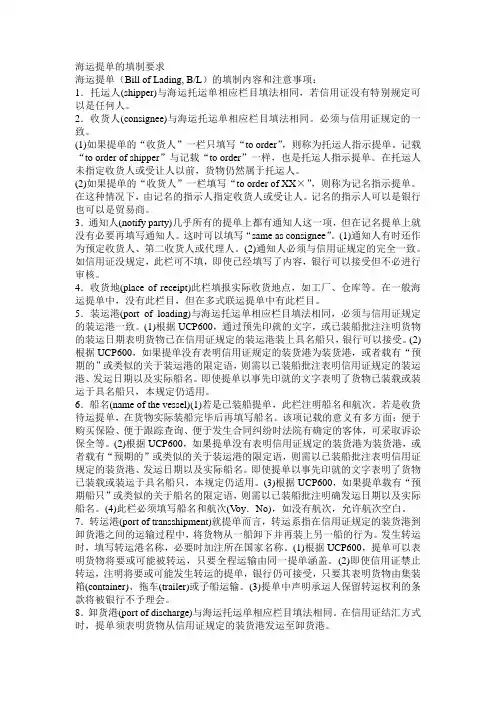
海运提单的填制要求海运提单(Bill of Lading, B/L)的填制内容和注意事项:1.托运人(shipper)与海运托运单相应栏目填法相同,若信用证没有特别规定可以是任何人。
2.收货人(consignee)与海运托运单相应栏目填法相同。
必须与信用证规定的一致。
(1)如果提单的“收货人”一栏只填写“to order”,则称为托运人指示提单。
记载“to order of shipper”与记载“to order”一样,也是托运人指示提单。
在托运人未指定收货人或受让人以前,货物仍然属于托运人。
(2)如果提单的“收货人”一栏填写“to order of XX×”,则称为记名指示提单。
在这种情况下,由记名的指示人指定收货人或受让人。
记名的指示人可以是银行也可以是贸易商。
3.通知人(notify party)几乎所有的提单上都有通知人这一项,但在记名提单上就没有必要再填写通知人。
这时可以填写“same as consignee”。
(1)通知人有时还作为预定收货人、第二收货人或代理人。
(2)通知人必须与信用证规定的完全一致。
如信用证没规定,此栏可不填,即使已经填写了内容,银行可以接受但不必进行审核。
4.收货地(place of receipt)此栏填报实际收货地点,如工厂、仓库等。
在一般海运提单中,没有此栏目,但在多式联运提单中有此栏目。
5.装运港(port of loading)与海运托运单相应栏目填法相同,必须与信用证规定的装运港一致。
(1)根据UCP600,通过预先印就的文字,或已装船批注注明货物的装运日期表明货物已在信用证规定的装运港装上具名船只,银行可以接受。
(2)根据UCP600,如果提单没有表明信用证规定的装货港为装货港,或者载有“预期的”或类似的关于装运港的限定语,则需以已装船批注表明信用证规定的装运港、发运日期以及实际船名。
即使提单以事先印就的文字表明了货物已装载或装运于具名船只,本规定仍适用。
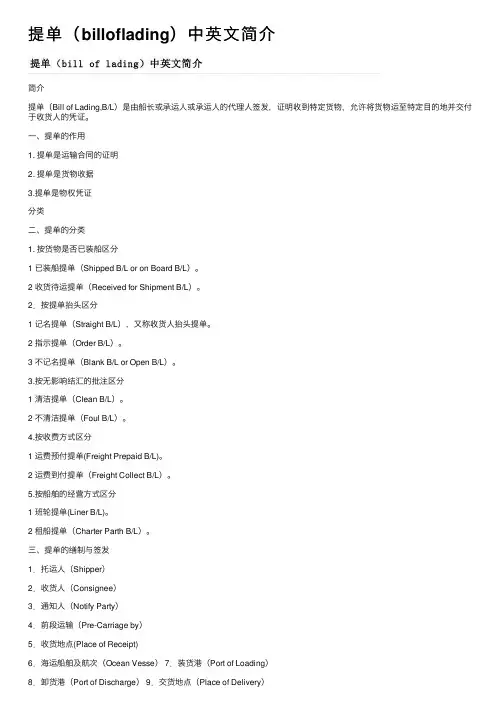
提单(billoflading)中英⽂简介简介提单(Bill of Lading,B/L)是由船长或承运⼈或承运⼈的代理⼈签发,证明收到特定货物,允许将货物运⾄特定⽬的地并交付于收货⼈的凭证。
⼀、提单的作⽤1. 提单是运输合同的证明2. 提单是货物收据3.提单是物权凭证分类⼆、提单的分类1. 按货物是否已装船区分1 已装船提单(Shipped B/L or on Board B/L)。
2 收货待运提单(Received for Shipment B/L)。
2.按提单抬头区分1 记名提单(Straight B/L),⼜称收货⼈抬头提单。
2 指⽰提单(Order B/L)。
3 不记名提单(Blank B/L or Open B/L)。
3.按⽆影响结汇的批注区分1 清洁提单(Clean B/L)。
2 不清洁提单(Foul B/L)。
4.按收费⽅式区分1 运费预付提单(Freight Prepaid B/L)。
2 运费到付提单(Freight Collect B/L)。
5.按船舶的经营⽅式区分1 班轮提单(Liner B/L)。
2 租船提单(Charter Parth B/L)。
三、提单的缮制与签发1.托运⼈(Shipper)2.收货⼈(Consignee)3.通知⼈(Notify Party)4.前段运输(Pre-Carriage by)5.收货地点(Place of Receipt)6.海运船舶及航次(Ocean Vesse) 7.装货港(Port of Loading)8.卸货港(Port of Discharge) 9.交货地点(Place of Delivery)10. 唛头和号码、集装箱箱号和铅封号(Marks & Nos.、Container.Seal No.)11.集装箱数或件数(No of Container or P kgs)12.包装种类、货物名称(Kind of Packages、Description of Goods)13.⽑重(Gross Weight kgs)14.体积(Measurement)15.运费和费⽤、付款地点及付款⽅式(Freight & Charges、Prepaid at、Payable at、Pre-paid、Collect)16.提单号和正本提单份数(B/L No.、No.of Original B(s)/L)17.签单地点和⽇期(Place and Date of Issue)18.代表承运⼈签字(Signed for the Carrier)区别四、B/L与D/O的区别B/L:BILL OF LADING提单,是货物的物权凭证。

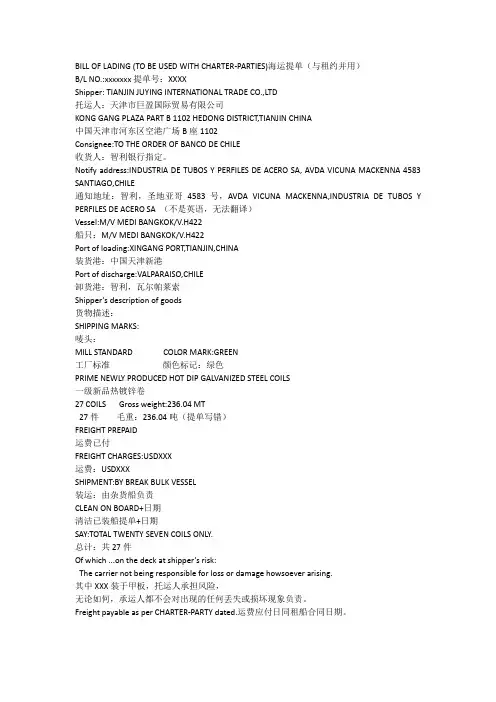
BILL OF LADING (TO BE USED WITH CHARTER-PARTIES)海运提单(与租约并用)B/L NO.:xxxxxxx提单号:XXXXShipper: TIANJIN JUYING INTERNATIONAL TRADE CO.,LTD托运人:天津市巨盈国际贸易有限公司KONG GANG PLAZA PART B 1102 HEDONG DISTRICT,TIANJIN CHINA中国天津市河东区空港广场B座1102Consignee:TO THE ORDER OF BANCO DE CHILE收货人:智利银行指定。
Notify address:INDUSTRIA DE TUBOS Y PERFILES DE ACERO SA, AVDA VICUNA MACKENNA 4583 SANTIAGO,CHILE通知地址:智利,圣地亚哥4583号,AVDA VICUNA MACKENNA,INDUSTRIA DE TUBOS Y PERFILES DE ACERO SA (不是英语,无法翻译)Vessel:M/V MEDI BANGKOK/V.H422船只:M/V MEDI BANGKOK/V.H422Port of loading:XINGANG PORT,TIANJIN,CHINA装货港:中国天津新港Port of discharge:VALPARAISO,CHILE卸货港:智利,瓦尔帕莱索Shipper’s description of goods货物描述:SHIPPING MARKS:唛头:MILL STANDARD COLOR MARK:GREEN工厂标准颜色标记:绿色PRIME NEWLY PRODUCED HOT DIP GALVANIZED STEEL COILS一级新品热镀锌卷27 COILS Gross weight:236.04 MT27件毛重:236.04吨(提单写错)FREIGHT PREPAID运费已付FREIGHT CHARGES:USDXXX运费:USDXXXSHIPMENT:BY BREAK BULK VESSEL装运:由杂货船负责CLEAN ON BOARD+日期清洁已装船提单+日期SAY:TOTAL TWENTY SEVEN COILS ONLY.总计:共27件Of which ...on the deck at shipper’s risk:The carrier not being responsible for loss or damage howsoever arising.其中XXX装于甲板,托运人承担风险,无论如何,承运人都不会对出现的任何丢失或损坏现象负责。
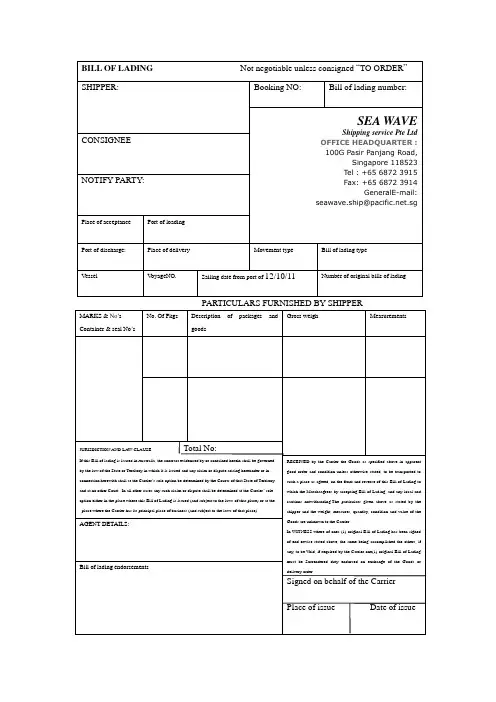
PARTICULARS FURNISHED BY SHIPPERMARKS & No’s Container & seal No ’sNo. Of PkgsDescription of packages and goodsGross weighMeasurementsJURISDICTION AND LAW CLAUSETotal No:If this Bill of lading is issued in Australia, the contract evidenced by or contained herein shall be governedby the law of the State or Territory in which it is issued and any claim or dispute arising hereunder or in connection herewith shall at the Carrier ’s sole option be determined by the Courts of that State of Territory and at no other Court,. In all other cases any such claim or dispute shall be determined at the Carrier ’ sole option either in the place where this Bill of Lading is issued (and subject to the laws of that place) or at theplace where the Carrier has its principal place of business (and subject to the laws of that place).RECEIVED by the Carrier the Goods as specified above in apparentgood order and condition unless otherwise stated, to be transported to such a place as agreed, on the front and reverse of this Bill of Lading to which the Marchaagrees by accepting Bill of Lading, and any local and cautions notwithsnding.The particulars given above as stated by theshipper and the weight, measures, quantity, condition and value of theGoods are unknown to the Carrier.In WITNESS where of ones (1) original Bill of Lading has been signed of end erwise stated above, the some being accomplished the others, if any, to be V oid, if required by the Carrier one(1) original Bill of Lading must be Surrendered duty endorsed on exchange of the Goods ordelivery order.Signed on behalf of the CarrierPlace of issue Date of issueAGENT DETAILS:Bill of lading endorsementsBILL OF LADING Not negotiable unless consigned “TO ORDER ” SHIPPER:Booking NO:Bill of lading number:SEA WAVEShipping service Pte LtdOFFICE HEADQUARTER : 100G Pasir Panjang Road,Singapore 118523 Tel : +65 6872 3915 Fax: +65 6872 3914GeneralE-mail:seawave.ship@.sgCONSIGNEENOTIFY PARTY:Place of acceptancePort of loadingPort of discharge: Place of deliveryMovement typeBill of lading typeVesselV oyageNO.Sailing date from port of 12/10/11Number of original bills of lading。
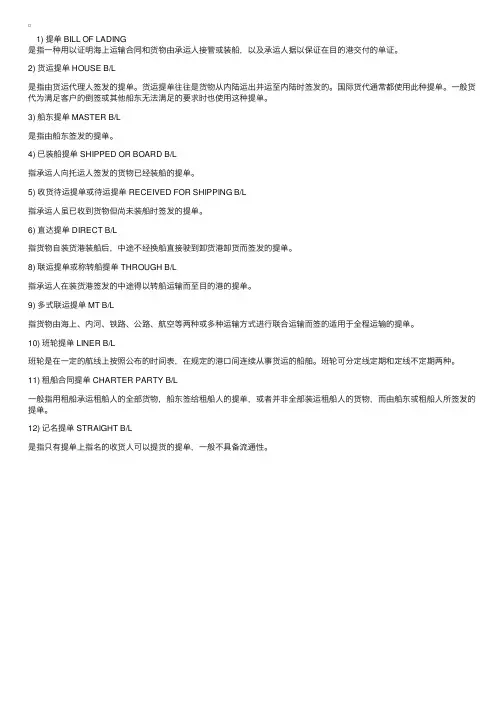
1) 提单 BILL OF LADING是指⼀种⽤以证明海上运输合同和货物由承运⼈接管或装船,以及承运⼈据以保证在⽬的港交付的单证。
2) 货运提单 HOUSE B/L是指由货运代理⼈签发的提单。
货运提单往往是货物从内陆运出并运⾄内陆时签发的。
国际货代通常都使⽤此种提单。
⼀般货代为满⾜客户的倒签或其他船东⽆法满⾜的要求时也使⽤这种提单。
3) 船东提单 MASTER B/L是指由船东签发的提单。
4) 已装船提单 SHIPPED OR BOARD B/L指承运⼈向托运⼈签发的货物已经装船的提单。
5) 收货待运提单或待运提单 RECEIVED FOR SHIPPING B/L指承运⼈虽已收到货物但尚未装船时签发的提单。
6) 直达提单 DIRECT B/L指货物⾃装货港装船后,中途不经换船直接驶到卸货港卸货⽽签发的提单。
8) 联运提单或称转船提单 THROUGH B/L指承运⼈在装货港签发的中途得以转船运输⽽⾄⽬的港的提单。
9) 多式联运提单 MT B/L指货物由海上、内河、铁路、公路、航空等两种或多种运输⽅式进⾏联合运输⽽签的适⽤于全程运输的提单。
10) 班轮提单 LINER B/L班轮是在⼀定的航线上按照公布的时间表,在规定的港⼝间连续从事货运的船舶。
班轮可分定线定期和定线不定期两种。
11) 租船合同提单 CHARTER PARTY B/L⼀般指⽤租船承运租船⼈的全部货物,船东签给租船⼈的提单,或者并⾮全部装运租船⼈的货物,⽽由船东或租船⼈所签发的提单。
12) 记名提单 STRAIGHT B/L是指只有提单上指名的收货⼈可以提货的提单,⼀般不具备流通性。
海运提单的种类海运提单(ocean bill of lading)是海上运输的承运人和收货人之间的一种货物运输合同。
在货物运输的过程中,海运提单是非常重要的一种文件,它是承运人和收货人之间约定的证明和凭证,记录着货物的名称、数量、价格和运输日期等重要信息。
根据不同的功能和约定,海运提单可以分为以下几种类型:一、海运提单分类:1.到岸提单(On Board Bill of Lading,简称OBL):到岸提单是指货物到达目的港口后,由承运人发给收货人的提单。
OBL是最基本的提单形式,它证明了承运人已经收到了货物并安全地运输到了目的港口。
在对货物拥有权和控制权的方面,OBL是非常重要的,因为它向银行和海关等第三方机构证明了货物的所有权。
2.直达提单(直达提单,简称DDL)直达提单可以在货物到达目的港口之前,承运人通过电子邮件或其他电子手段发给收货人。
该类提单可以加强收货人的对货物的掌控,有利于在加工环节中更为灵活高效的开展操作,因此受到越来越多的关注和重视。
3.转运提单(Through Bill of Lading,简称TBL):转运提单是指在海上运输中,货物经过一个或者多个中转点,由其中一个承运人运送至目的地。
对于TBL的发行而言,它需要承运人与中转、或者直达到达港口的发运人之间达成协议,确认转运事项并确保货物可以按照中转计划项下被送达。
4.分拆提单(Split Bill of Lading,简称SBL):分拆提单是指品质或者数量相同的货物,运输时被分成两个或者更多的运单。
这种情况在海上运输中比较常见,对于承运人和收货人之间的关系更为复杂和有挑战。
5.空运提单(Airway Bill of Lading,简称AWB):在空运中使用的提单是空运提单(AWB)。
操作方式类似于海运提单,可以通过电子邮件或其他电子方式进行传输,发放者发出该单可以证明其已经承运该批货物,对于航空货物的掌控有着重要的意义。
二、海运提单交单方式1.电放提单(Telex Release):电放提单是指承运人发给收货人的一种提运工具,由于这种提单的传播方式是通过电传或者电子邮件,其性质类似于电子凭证,简单、快捷、安全、可靠,在国际贸易中扮演了越来越重要的角色。
中国远洋运输公司提单什么是提单?提单(Bill of Lading)是国际贸易中常见的货运单证之一,也是一种合同文件。
在海上运输中,提单被用作货物所有权的证明和有效货运合同的标志。
提单还包括各种运输细节,如装载和卸货港口、货物种类和数量、船名和航次、运费等。
提单由船东或航运代理人签发,并由托运人通过该单证授权第三方取得该货物。
中国远洋运输公司提单介绍中国远洋运输公司是中国最大的航运公司之一,其提单是国际贸易中最常见的货运单证之一。
中国远洋运输公司提单是其客户与公司之间签订的一份运输合同,是证明收到了某单货物的纸质凭证。
中国远洋运输公司提单分为两种,一种是海运提单(Ocean Billof Lading),另一种是内河/海河提单(Inland/Sea Waybill)。
两种提单均是合同的证明文件,但在规范、使用方式以及强制力等方面有所不同。
海运提单海运提单是中国远洋运输公司为国际海洋运输提供的保证单,是国际交易中最常用的提单种类之一。
海运提单一经签发即具有法律效力,可以证明货物资产权归属和货物数量等运输细节,也是各国海关的重要凭证。
海运提单的内容主要包括:1.起运地和目的地2.船名和航次3.货物描述、数量和品牌4.托运人和收货人信息5.贸易条款6.运费和保险费7.抵达目的港时间和地点内河/海河提单内河/海河提单是中国远洋运输公司为国内/区域性航运提供的货运单据,是与海运提单相对应的另一种提单形式。
内河/海河提单的适用范围包括内河运输、内陆运输以及河运和海河运输。
内河/海河提单与海运提单相比,由于没有海洋航线和国际贸易等的限制,通常规范、使用及有效力度较海运提单低,也容易被各国海关拒绝接受。
所以,内河/海河提单更多的是在国内运输中进行使用。
内河/海河提单的内容主要包括:1.起运地和目的地2.船名和航次3.货物描述、数量和品牌4.托运人和收货人信息5.运费和保险费6.抵达目的港时间和地点中国远洋运输公司提单的重要性提单是国际贸易中非常重要的证明,对于保证进出口贸易流通十分重要。
etc海运术语ETC海运术语在国际贸易和海运行业中,ETC(Electronic Transport Control)海运术语是非常重要的一部分。
ETC海运术语用于描述与货物运输、仓储和相关服务相关的各种术语和定义。
以下是一些常见的ETC海运术语的介绍:1.提单(Bill of Lading):提单是海运运输中最重要的文件之一,它是货物所有权的证明以及运输合同的重要组成部分。
在货物装上船前,船公司会向货主或托运人签发提单。
提单上包含了货物的描述、数量、装运日期、起运港口、目的港口等信息。
2.提单正本(Original Bill of Lading):提单正本是指正式的原始提单,具有法律效力并且可转让。
货主需要通过提单正本来领取货物或将货物转让给其他人。
提单正本通常以纸质形式存在,货主需要妥善保管并在需要时提交给相关方。
3.提单副本(Copy Bill of Lading):提单副本是提单的复印件或电子版本。
它通常用于报关、保险和其他与运输相关的业务,但不具备货物所有权转让的功能。
4.运单(Waybill):运单是与提单类似的文件,用于描述货物的数量、种类和运输细节。
与提单不同的是,运单一般不可转让,货物的提取和交付可以凭借运单而无需提单正本。
5.港口代理(Port Agent):港口代理是在港口地区提供代理服务的公司或个人。
他们负责处理船舶和货物的各类手续,包括报关、装卸货物、安排船舶的停靠和离港等。
6.集装箱(Container):集装箱是一种用于装载和运输货物的标准化货柜。
它具有标准的尺寸和结构,方便货物的装卸和运输。
集装箱通常由金属制成,具有防水和防盗的功能。
7.拼箱(LCL,Less than Container Load):拼箱是指将多个不同货主的货物组合在同一个集装箱中进行运输的方式。
拼箱通常适用于货物数量较少,无法填满整个集装箱的情况。
8.整箱(FCL,Full Container Load):整箱是指将一个货主的货物装满一个集装箱进行运输的方式。
海运提单的基本概念在看提单之前,先普及一下海运提单的基本概念。
海运提单(Ocean/Marine Bill of Lading)是指是承运人签发给托运人的收据,确认承运人已收到提单所列货物以及装货上船,是托运人与承运人的运输契约证明,同时也代表货物所有权的凭证。
海运提单按签发对象不同可分为船东提单和货代提单,船东提单就是我们平常说的主单MBL(Master Bill of Lading),又称船东单、海单或者大单,而货代提单就是我们经常听到的分单HBL(House Bill of Lading),又称货代单或者小单。
2海运提单签发流程海运提单的一般签发流程是:发货人Shipper填写好订舱委托书Booking给货运代理,货运代理向船公司订舱获取SO放给Shipper,Shipper装柜提交补料后船公司签发MBL给货运代理,货代签发HBL给发货人。
因此,MBL上面的Shipper是货代,Consignee和Notify Party是货代的目的港代理(老王注:这是指指定货代的情况下。
非指定货的,主单shipper为出口企业即货主,船公司或船代直接签发给出口企业)。
而HBL上面的Shipper是发货人,Consignee 是国外收货人。
国外收货人如果拿到的是MBL可以直接向船公司办理提货,如果拿到的是HBL需要先向目的港代理换取MBL,然后再用MBL去办理提货单D/O进行提货。
还有一种情况是,客户直接和船公司对接订舱,此时可以直接出船东单,但如果是散货拼柜的话就一定是只能拿到分单,因为MBL只针对整柜运输,同时船公司也不牵涉拼柜业务,拼柜是由市场的散货拼柜公司直接向船公司订舱。
正因如此,我们大部分业务操作中经常拿到的是分单,这篇文章的主要适用对象也是我们的海派运营操作人员。
3剖析海运提单具体内容接下来给大家讲解分单上面各个框的内容含义,首先需要知道的是其实各家船公司或者代理的提单格式不是完全相同的,但是提单上内容和要素基本是一致的,Vin Gor 找了一份以前自己出过的内容相对“饱满”的提单样本,如下图所示,各个框我都标注上号码,框里具体的内容已经被我抹掉,但不妨碍整份提单的解读。
海运业务词汇(常用海运英文)1. 运输术语Bill of Lading (B/L): 提单,是海运货物交接的凭证,证明承运人已收到货物并承诺按照合同条款运输。
Container: 集装箱,用于装载货物的标准尺寸的金属箱。
Freight: 货物,泛指运输的物品。
Charter Party: 租船合同,船东与租船人之间订立的协议,规定船舶的租赁条款。
Cargo Manifest: 货物清单,列明船上所有货物的详细信息。
Customs Clearance: 清关,指货物进出口时,必须经过海关的检查和批准。
2. 船舶术语Vessel: 船舶,泛指各种水上交通工具。
Ship: 船,通常指较大的船舶。
Barge: 驳船,用于运输货物的小型船只。
Hull: 船体,指船舶的主体结构。
Deck: 甲板,船舶的上层结构。
Hold: 货舱,用于装载货物的船舱。
Bridge: 驾驶室,船舶的指挥中心。
3. 货物类型Dry Bulk: 干散货,指非液体、非包装的散装货物,如煤炭、矿石等。
Liquid Bulk: 液体散货,指液体状态的散装货物,如原油、化学品等。
General Cargo: 杂货,指各种类型的货物,通常需要包装。
Reefer Cargo: 冷藏货物,指需要冷藏运输的货物,如冷冻食品、药品等。
Dangerous Goods: 危险品,指具有易燃、易爆、有毒等特性的货物。
4. 其他常用术语ETD (Estimated Time of Departure): 预计离港时间。
ETA (Estimated Time of Arrival): 预计到港时间。
Voyage: 航次,指船舶从一个港口到另一个港口的航行。
Port of Loading: 装货港,指货物装船的港口。
Port of Discharge: 卸货港,指货物卸船的港口。
Shipper: 托运人,指将货物交给承运人运输的人或公司。
Consignee: 收货人,指从承运人处接收货物的人或公司。
海上货物运输法规课程-4:提单1. 提单的定义提单(Bill of Lading,简称B/L)是指在海上货物运输中,由承运人(船东或船运代理人)向货主(托运人)发给的一种书面凭证,用于证明货物的装运和接收。
2. 提单的作用提单在海上货物运输中具有以下几个重要的作用:2.1 货物的证明提单是证明货物已经交由承运人承运的正式文件。
货主可以根据提单上的信息证明自己对该批货物的所有权,并且可以通过提单来要求承运人交付货物。
2.2 货物的装运和交付提单记录了货物的装运日期、装运港口以及目的港口等信息,承运人在接收货物时需要与提单上的信息进行核对。
同时,承运人在目的港口通过提单来确认货物的交付给收货人。
2.3 证明货物状况和数量提单上通常会记录货物的状况、数量以及包装方式等信息,这些信息对于货物的损失、损坏以及索赔等问题都至关重要。
因此,提单可以作为货物状况和数量的证据。
2.4 货物的质押和转让提单上的货物所有权可以通过背书或转让来变更,货主可以将货物的所有权转让给其他人。
此外,提单还可以用作货物质押的凭证,货主可以通过将提单质押给银行来获取融资支持。
根据受益人的不同,提单可以分为以下几种类型:3.1 直达提单直达提单是将货物直接运输到目的港口的提单,承运人会在目的港口将货物交付给收货人。
这种提单通常用于整船运输或长途直达运输。
3.2 转运提单转运提单是指货物需要经过中转港口的提单,承运人会在中转港口将货物交付给中转代理人,中转代理人会负责将货物运输到最终目的地。
这种提单通常用于多式联运或者货物需要经过多个港口的情况。
3.3 分单分单是指将一份提单拆分为多份以便不同的收货人接收货物,每份分单都具有相同的信息,但只能由指定的收货人使用。
这种提单通常用于拆分整船货物或者一个提单有多个收货人的情况。
空白提单是指没有填写具体收货人信息的提单,任何持有空白提单的人都可以成为货物的合法受益人。
空白提单通常由货主签发,并且可以多次转让所有权。
Bill of Lading 海运提单A bill of lading is a receipt for goods shipped on board a vessel, signed by the person (or his agent) who contracts to carry them, and stating the conditions in which the goods were delivered to (and received by) the ship. It is not the actual contract, but forms excellent evidence of the terms of the contract. It is a document of title to the goods, enabling the shipper or owner of the goods to endorse title to other parties, sell goods in transit, and present to banks with other documents in seeking payment under documentary credits. Abbreviated generally as B/L, it is the most important document for sea transport.There are different types of bill of lading:(1)Shipped (On Board) B/L and received for shipment B/L已装船提单和备运提单·Shipped B/L is issued by the shipping company after the goods are actually shipped on board the designatedvessel. Since shipped bill of lading provides better guarantee for the consignee to receive the cargo at the destination, the importer will normally require the exporter to produce shipped B/L and most bill of lading forms are preprinted as “Shipped Bill”.·Received for Shipment B/L arises where the word “shipped” does not appear on the bill of lading. It merely confirms that the goods have been handed over to, and are in the custody of the shipowner. The buyer under a CIF contract will not accept such a B/L because, in the absence of the date of shipment, he is in no position to anticipate the arrival of the consignment.(2)Clean B/L and unclean B/L清洁提单和不清洁提单· A clean bill of lading is the one that states that the goods have been “shipped in apparent good order and condition”. It is issued when the goods do not show any defects on their exteriors at the time of loading at the port of shipment. This type is favored by the buyer and the banks for financial settlement purposes.·If defects are found on the exteriors of the goods, or the shipping company does not agree to any of the statements in the B/L, the bill will be marked as “unclean”, “foul” or “… packages in damaged condition”. Unclean B/L is usually unacceptable to the buyer and banks.(3)Straight, blank and order B/L记名、不记名和指示提单·Straight bill of lading has a designated consignee. Under this bill, only the named consignee at the destination is entitled to take delivery of the cargo. As it is not transferable, it is not commonly used in international trade and normally applies to high-value shipments or goods for special purposes.·Blank B/L also called Open B/L or Bearer B/L, means that there is no definite consignee of the goods. There usually appear in the box of consignee words like “To bearer”. Anyone who holds the bill is entitled to the goods the bill represents. No endorsement is needed for the transfer of the blank bill. Due to the exceedingly highrisk involved, this bill is rarely used.·Order B/L is widely used in international trade. It means that the goods are consigned or destined to the order of a named person. In the box of consignee, “To order”, “To order of the shipper”, or “To order of the consignee” is marked. It can be transferred only after endorsement is made. If the B/L is made out “To order of the shipper”, the shipper will endorse the bill. If it is made out “To order of the consignee”, the consignee will endorse the bill to transfer it. A blank endorsement is usually required for a “To order” bill.(4)Direct, transshipment, through bill of lading 直运、转船和联运提单·Transhipment B/L means that the goods need to be transshipped at an intermediate port as there is no direct service between the shipment port and the destination port.·It is sometimes necessary to employ two or more carriers to get the goods to their final destination. In thiscase, usually the first carrier will sign and issue a through bill of lading. The on-carriage may be either by a second vessel or by a different form of transport.(5)Liner B/L, container B/L and combined transport B/L班轮、集装箱和多式联运提单·Liner bill of lading is issued by a liner company for shipment on scheduled port calls through scheduled routes.·Container B/L is becoming more common in use with the development of containerization. It covers the goods from port to port or from inland point of departure to inland point of destination.·Combined transport B/L is issued by combined transport operator that covers the multi-modal transport on a door-to-door basis in one contract of carriage. It is ideal for container movements. It differs from “through B/L” in that combined transport is operated by only one carrier.(6)Long form B/L and short form B/L全式提单和简式提单·Long form B/L is more detailed with shipping contract clause printed on the back of the page.·Short form B/L, as the name implies, is an abbreviated type of document, smaller and not containing the long list of detailed clauses that generally appear on bills of lading. In certain circumstances it may not, therefore, be considered a suitable form of evidence of contract or affreightment.(7)On Deck B/L, stale B/L, ante-dated B/L and advanced B/L舱面提单、过期提单、倒签提单和预签提单·On Deck B/L is issued when the cargo is loaded on the ship’s deck. It applies to goods like livestock, plants, dangerous cargo, or awkwardly-shaped goods that can not fit into the ship’s holds. In this case, the goods are exposed to greater risks and therefore usually specific insurance must be taken out against additional risks.·It is important that the Bill of Lading is available at the port of destination before the goods arrive or, failing this, at the same time. Bills presented to the consignee or buyer or his bank after the goods are due at the port of destination are described as “Stale Bs/L”. As a cargo cannot be collected by the buyer without the Bill of Lading, the late arrival of this all-important document may have undesirable consequences such as warehouse rent, etc. and therefore should be avoided. Sometimes especially in the case of short sea voyages, it is necessary to add a clause of “Stale B/L is acceptable”.·Ante-dated B/L means when the actual shipment date is later than that stipulated in the L/C, the carrier sometimes, at the shipper’s request, issues a B/L with a date of signature that suits the requirement so as to avoid non-acceptance by the bank. Due to the risk of the goods being rejected by the buyer arising from the issuance of such a bill, it is advisable to avoid this mal practice even when it seems necessary in certain circumstances.·Advanced B/L is issued when the expiry date of the L/C is due but the exporter hasn’t yet got the goods ready for shipment. The purpose of issuing such a bill is to negotiate payment with the bank in time within the validity of the L/C. it is also regarded as unlawful and risky and should be avoided.Still there are some other types of B/L such as Groupage B/L which covers a number of consignments from different shippers, and House B/L issued by a freight forwarder to each individual shipper, and so on. House B/L is issued By the freight forwarder before he gets one groupage B/L from the shipowner.All the above mentioned bills are not independent of each other. Several types may be combined into one like “Clean on board, to order, blank endorsed B/L”. A received for shipment bill may also be a straight and clean bill. Bills of lading are made out in sets, consisting of a number of originals (usually three) and a number of copies and marked” and “copy” respectively. Only the originals signed by the carrier enable the consignee totake delivery of the goods. The copies are just for reference.Types of Risks, Losses and Expenses Covered(1)Two types of risks are covered by ocean marine insurance:One is the perils of the sea, including both natural calamities and unexpected accidents. Natural calamities include heavy weather, lightening, Tsunami, earthquake, volcanic eruption and so on. Accidents refer to fire, explosion, vessel being stranded, grounded, sunk or capsized, collision or contact of vessel with any external object other than water, etc.The other type of risks is external (extraneous) risks including general external risks and special external risks. General external risks include theft and pilferage, contamination, leakage, breakage, sweating and/or heating, taint of odor, rusting, hook damage, fresh and/or rain water damage, short-delivery and non-delivery, shortage in weight, clashing and so on. Special risks include war, strike, failure to deliver due to some special laws or regulations.(2)Two types of losses are covered by marine cargo insurance. One is total loss and the other partial loss.Total loss is divided into actual total loss and constructive total loss. Actual total loss means the complete loss of the insured cargo in value.A constructive total loss occurs when the cost of salvaging the shipment would be more than the salvaged value of the merchandise. The shipment insured is reasonably abandoned as any further efforts at salvage would be fruitless. Most insurance policies provide for the payment of a total loss up to the insured amount.Partial loss means the loss of part of the insured cargo. It can be divided into generalaverage and particular average:General average is based upon a relationship between the shipowner and all the shippers who have cargo aboard the same vessel on a particular voyage. All these parties are bound together in the “adventure”. Sometimes, when the whole ship was threatened by a peril of the sea or some other hazard, in order to save he ship and some of the cargo or vessel have to be sacrificed, then an act of general average would be declared. According to maritime law, those interests whose property was saved must contribute proportionally to cover the losses of the one whose property was voluntarily sacrificed.·Particular average means a partial loss suffered by part of the cargo. It occurs when a storm or fire damages part of the shipper’s cargo and no one else’s cargo has to be sacrificed to save the voyage. The cargo owner whose goods were damaged or lost should refer to his insurance company, provided hispolicy covers the specific type of loss suffered.(3)Ocean cargo insurance also covers the expenses incurred to avoid or reduce the damage to or loss of the subject matter insured. There are mainly two types of expenses. One is sue and labor expenses paid by the assured or his agent. The other is salvage charge paid by the party other than the insurer and /or the insured.Main Types of Insurance 主要的保险种类There are mainly two types of insurance coverage, basic coverage and additional coverage. Basic coverage mainly includes FPA, WPA and All Risks. Additional coverage includes general additional coverage and special additional coverage.(1)FPA (Free from Particular Average) is alimited form of cargo insurance cover under which no partial loss or damage is recoverable. It only provides coverage for total losses and general average emerging from the actual “marine perils” like vessel being stranded, grounded or sunk.(2)WPA (With Particular average) is a wider cover than FPA. It provides extensive cover against all loss or damage due to marine perils throughout the duration of the policy, including partial loss or damage which may be attributed to natural calamities like heavy weather.(3)All Risks is the most comprehensive of the three basic coverages under which the insurer is responsible for all total or partial loss of, or damage to the goods insured either arising from sea perils or general external causes. However, it does not cover loss, damage or expense caused by delay, inherentvice or nature of the goods insured, or special external risks of war, strike, etc.(4)General additional risks include TPND (Theft, Pilferage and Non-delivery), Fresh and/or Rain Water Damage, Risk of Shortage, Risk of Intermixture and Contamination, Risk of Leakage, Risk of Clash and Breakage, Risk of Odor, Damage caused by Heating and/or Sweating, Hook Damage, Risk of Rust, etc. These additional risks can not be covered independently and should go with FPA or WPA and are included in All Risks coverage.(5)Special additional risks include War Risk, Strikes Risk(SRCC, Strikes, Riots & Civil Commotions), Failure to Deliver Risk, Import Duty Risk, On Deck Risk, Rejection Risk, etc., among which war risk and strikes risk are more common. These additional coverages are usually taken out together with FPA, WPA and All risks.To choose an insurance coverage that is both economical and effective, the exporter or the importer should be aware of the possible losses to be expected of a particular consignment. Different items have different natures and may apply to different insurance types. For example, cargo like iron ore faces little risk of partial loss, so FPA will be sufficient. Most manufactured goods are covered against All Risks as they are prone to damage caused by sea perils or external risks. It is important that the Bill of Lading is available at the port of destination before the goods arrive or, failing this, at the same time. Bills presented to the consignee or buyer or his bank after the goods are due at the port of destination are described as “Stale Bs/L”. As a cargo cannot be collected by the buyer without the Bill of Lading, the late arrival of this all-important document may have undesirable consequences such aswarehouse rent, etc. and therefore should be avoided. Sometimes especially in the case of short sea voyages, it is necessary to add a clause of “Stale B/L is acceptable”.> shipping advice -- to importer ]. It is due.We have informed your agents,name], who will arrange for the consignment to be sent on to you, as you requested. Our bank's, will hand over the following documents once you have accepted our bill:We hope the goods will arrive in perfect condition and find a ready market in your country.Sincerely yours,Letter 11.As the contracted time of delivery is rapidly falling due, it is imperative that you inform us the delivery time without any further delay.Letter 21.Today we’ll ship the above consignment on board S.S“Nellore” which sails for your port tomorrow.2.Fill: fulfill; executeLetter 31.As our client requires us to ship the goods not later than July 15, please quote us for a shipping container from HongKong to the above mentioned port before that deadline2.Take loads: 装载Letter 41.There are about 2 to 3 sailings weekly from Shanghai to Hong Kong.2.Freight : 运费Letter 51. The main reason is that their steamers offer the shortest time for the journey between China and Germany. We shall appreciate it if you will endeavor to ship the consignments as follows.Letter 61. We enclose our invoice and shall present shipping documents and our draft for acceptance through the Royal Bank, Shanghai Office, as agreed. According to the terms of Contract No.318, shipment is to be effected by the 20th Jan., and we must have the B/L by the 31st at the latest. We trust you will ship the order within the stipulated time as any delay would cause us no little inconvenience and financial loss. We regret our inability to comply with your request for shipping the goods in early December, because the direct steamer sailingfor London calls at our Port only around the 20th every month.We are pleased to inform you that the goods under your Order No.1234 were shipped by the direct steamer “Red Star ” on Nov.30, and the relevant shipping samples had been dispatched to you by air before the steamer sailed.With regard to your Order No. 80 for 500 Sewing Machines, we shipped the goods by s.s. “East Wind”on 30th Nov. We trust that this shipment will arrive at your end shortly. Please let us have the comments of your end-users on the quality of our Sewing Machines.Write a letter to your customer to urge shipment of Blue Wollen Serge under Order No.5781. The relevant L/C has been extended to 31st match.Dear sirs,We wish to invite your attention to our Order No.5781 covering 500 pieces Blue Woolen Serge, forwhich we sent to you about 30 days ago an irrevocable L/C expiration date 31st March.As the season is rapidly approaching, our buyers are badly in need of the goods. We shall be very much obliged if you will effect shipment as soon as possible, thus enabling them to catch the brisk demand at the start of the season. We would like to emphasize that any delay in shipping our booked order will undoubtedly involve us in no small difficulty.We thank you in advance for your cooperation.Yours faithfully,。